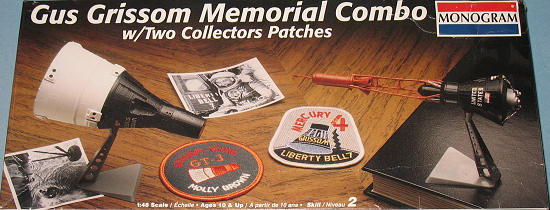
Monogram
1/48 Gus Grissom Memorial Combo
| KIT #: | 85-4166 |
| PRICE: | $ |
| DECALS: | Two options |
| REVIEWER: | Dan Lee |
| NOTES: |
Two kits in one.
Inaccurate, but the only
game in town for 1/48 scale |

| HISTORY |
Commander Virgil “Gus” Grissom
Virgil “Gus” Grissom was one of the original Mercury
Seven astronauts (including John Glenn, Alan Shephard, Deke Slayton, Gordon
Cooper, Scott Carpenter and Wally Schirra.(
He was born in 1926, joined the USAAF as a clerk in
1944, demobilized in 1945 and graduated from Purdue University with a degree in
mechanical engineering.
He rejoined the USAF in 1950 as an aviation cadet and
eventually found himself flying F-86 Sabres in Korea with the 334th FS.
He flew 100 missions and returned to the States as an
instructor pilot.
He was soon found to have the “Right Stuff” and ended up
at Edwards as a test pilot.
From there, he applied to be one of the first group of
astronauts and endured many rigorous if not odd scientific tests till he was
chosen as one of the Mercury Seven (as chronicled in Tom Wolfe’s great book,
“The Right Stuff.”)
He flew Liberty Bell 7 in July of 1961 and became the
2nd American in Space.
The suborbital shot was uneventful until splashdown when
the capsule’s escape hatch’s explosive bolts exploded mysteriously and water
started flooding in.
Grissom nearly drowned as water got into his space suit
and was rescued by Navy rescue divers.
Officially NASA said it was a mysterious accident, but
privately many suspected that Grissom was responsible for blowing the hatch, but
Grissom said he did nothing to set it off.
In 1999, Liberty Bell 7 was recovered in a salvage
operation and it turned out that Grissom was not at fault.
Gus’ next mission was Gemini 3, the first manned
flight of the Gemini Capsule.
He and his pilot, John Young, had a very wry black sense
of humor and they decided to name their capsule “The Unsinkable Molly Brown”
after the Broadway play.
This name was not well received by the PR conscious NASA
(the alternative name forwarded by the crew was Titanic) and was not so named in
the official press releases.
Thanks to CAPCOM Astronaut Gordon Cooper, the name stuck
and ended NASA’s naming of each space capsule until the Apollo missions.
Unfortunately, Gus Grissom died in the first fatal spacecraft accident in NASA’s history on January 27, 1967 during a test of the Apollo Command module along with crewmen Ed White and Roger Chaffee. Later, it was discovered post accident that the Apollo capsule was a fire hazard due to the many design shortcuts to get a man on the moon.
| THE KIT |
 This
kit(s) was/were first produced in 1964 and is pretty good for a kit of that era.
It consists of 144 parts for both kits and comes with a
small decal sheet, a thin sheet of clear acetate for the windows and two
collectable mission patches.
The parts show their age as there is some flash around
most if not all the parts.
From what I have read, the fit is not so hot, but still
useable.
Both kits capture the corrugated surface detail and raised rivets
nicely.
However, both are very inaccurate though.
This
kit(s) was/were first produced in 1964 and is pretty good for a kit of that era.
It consists of 144 parts for both kits and comes with a
small decal sheet, a thin sheet of clear acetate for the windows and two
collectable mission patches.
The parts show their age as there is some flash around
most if not all the parts.
From what I have read, the fit is not so hot, but still
useable.
Both kits capture the corrugated surface detail and raised rivets
nicely.
However, both are very inaccurate though.
To be fair, the Gemini capsule model was released
before Gemini flew based on a prototype that used a hang glider contraption and
landing skids.
This version never flew and the skid doors were never added to
the capsule which means that any capsule produced is going to be horribly wrong.
However, it is not easy to replace as the surface detail
makes it difficult for all but the most able craftsman with extreme patience.
Plus the nose and cockpit are Spartan and devoid of
important detail (one can avoid showing the cockpit by closing up the capsule.)
The Mercury capsule suffers from a lack of cockpit detail which does not capture how incredibly cramped the capsule was and there is a problem with the nose as it is too narrow when compared to photos of the real thing.
| CONCLUSIONS |
If you want a somewhat more accurate Mercury and
Gemini capsules, you will need a correction set for each.
The only correction sets that are available for both
that I know of are made by Real Space Models (note, I have no personal
affiliation with the company.)
Again, to be fair, the kits are still adequate for an OOB build if the accuracy and shape issues do not bother you.
July 2009
If you would like your product reviewed fairly and quickly, please contact me or see other details in the Note to Contributors.